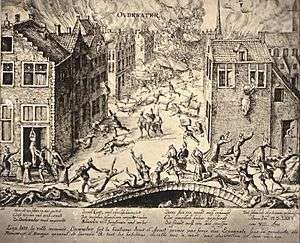Eighty Years' War (1566–1609)
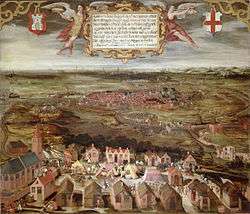
The first half of the Eighty Years' War between the Spanish Empire and the Dutch Republic was fought between 1566 and 1609. When the Twelve Years' Truce was signed in 1609, ending this first phase of war, the northern Netherlands had achieved de facto independence.
Insurrection, repression and invasion (1566–1572)

Calvinist protest against the wealth of the church led to the iconoclastic fury (Dutch: Beeldenstorm) across the Netherlands. The Governor of the Netherlands Margaret of Parma, as well as authorities at lower levels, feared insurrection and made further concessions to the Calvinists, such as designating certain churches for Calvinist worship. Some provincial governors, foremost Philip of Noircarmes of Hainaut, who suppressed the revolt of the Calvinists led by Guido de Bres in Valenciennes, and William of Orange as stadtholder of Holland and Zeeland, took decisive action to quell the disturbances. In March 1567 at the Battle of Oosterweel Calvinists under John of St. Aldegonde were defeated by a royalist army and all rebels summarily executed. In April 1567, Margaret reported to her brother Philip II that order had been restored.[1] However, by the time this news reached him in Madrid the Duke of Alba had already been dispatched with an army to restore order.[2] Rather than working with Margaret, Alba took over command and Margaret resigned in protest. Alba established the Council of Troubles (soon to be nicknamed the Blood Council) on 5 September 1567, which conducted a campaign of repression of suspected heretics and people deemed guilty of the already extinguished insurrection. Many high-ranking officials were arrested on various pretexts, among them the Counts of Egmont and Horne who were executed for treason on 5 June 1568 while attesting to their Catholic orthodoxy on the scaffold. Of the 9,000 accused, about 1,000 were executed, and many fled into exile, including William of Orange.[3]
Orange's exile in Dillenburg became the center for plans to invade the Netherlands. Louis of Nassau crossed into Groningen from East Friesland and defeated a small royalist force at Heiligerlee on 23 May 1568. Two months after, the Dutch rebels were smashed at the Battle of Jemmingen. Shortly thereafter, a Sea Beggars squadron defeated a royalist fleet in a naval battle on the Ems. However, a Huguenot army invading Artois was pushed back into France and annihilated by the forces of Charles IX of France in June. Orange marched into Brabant, but with money running out he could not maintain his mercenary army and had to retreat.[4]
Philip was suffering from the high cost of his war against the Ottoman Empire, and ordered Alba to fund his armies from taxes levied in the Netherlands.[5] Alba went against the States General by imposing sales taxes by decree on 31 July 1571. Alba commanded local governments to collect the unpopular taxes, which alienated even loyal lower governments from the central government.[6]
Rebellion (1572–1576)
With the potential threat of invasions from France, Alba concentrated his force in the Southern Netherlands, in some cases removing troops from garrisons in the North.[7]
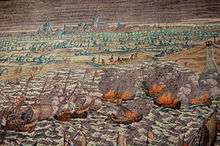

This left the port of Brill almost undefended. Sea Beggars expelled from England captured the city on 1 April 1572. An attempt by Count Boussu to recapture the city failed.[8] The news of the capture of Brill led the cities of Flushing and Veere to go over to the Rebels on 3 May.[9] Orange quickly responded to this new development, by sending a number of emissaries to Holland and Zeeland with commissions to take over local government on his behalf as "stadtholder".[10] Diederik Sonoy persuaded the cities of Enkhuizen, Hoorn, Medemblik, Edam, Haarlem, and Alkmaar to defect to Orange. The cities of Oudewater, Gouda, Gorinchem, and Dordrecht yielded to Lumey. Leiden declared itself for Orange in a spontaneous revolt. The States of Holland started to convene in the rebel city of Dordrecht,[11] and by 18 July, only the important cities of Amsterdam and Schoonhoven openly supported the Crown. Rotterdam went to the rebels soon after the first meetings in Dordrecht. Delft remained neutral for the time being.[12] Count Willem IV van den Bergh, Orange's brother-in-law, captured the city of Zutphen, followed by other cities in Gelderland and neighbouring Overijssel. In Friesland rebels had seized several cities. The royal stadtholder, Caspar de Robles sacked Dokkum in reprisal, killing many citizens [13] Louis of Nassau captured Mons by surprise on 24 May. Orange marched to Mons for support, but was forced to withdraw through Mechelen, where he left a garrison. Alba had troops sack Mechelen, after which many cities hastened to pledge renewed loyalty to Alba.[14]
After dealing with Orange's threat in the South, Alba sent his son Fadrique to the two rebellious provinces Gelderland and Holland. Fadrique started his campaign by sacking the fortress city of Zutphen in Gelderland. Hundreds of citizens perished and many rebellious cities in Gelderland, Overijssel and Friesland yielded.[15] On his way to Amsterdam, Fadrique came across Naarden, which surrendered on 22 November 1572; and to set another example, Fadrique herded all of Naarden's citizens (reportedly including a Roman Catholic priest) into their church, which was subsequently set on fire. All 3,000 citizens perished. This time however, this strengthened rebellious cities in their resistance, as they realised surrender would not help them.[16] In Haarlem the citizens, aware of the fate of Naarden, prevented capitulation and put up a resistance.[16] The city was under siege from December until 13 July 1573, when it collapsed due to hunger.[17] While the loss of Haarlem was a severe blow to the rebel cause, the siege had given the rebels time to improve their defences. The Siege of Alkmaar resulted in a rebel victory after the sluice gates were opened and the area surrounding the city was flooded, making a further siege impossible.[18] The city of Geertruidenberg was captured in a night time surprise attack by an English, French Huguenot and Fleming force on 28 August 1573 and in October and a Spanish attempt to take the city of Delft and its environs failed - which further boosted the morale of the rebels.
In the Battle on the Zuiderzee on 11 October 1573, a Sea Beggar squadron defeated the royalist fleet, thus placing the Zuiderzee under rebel control. A blockade against the royalist city of Amsterdam was established. The Battle of Borsele and the Battle of Reimerswaal established naval superiority for the rebels in Zeeland, and led to the fall of Middelburg in 1574, which had been besieged by the rebels since 1572.[19]
In November 1573, Fadrique started the siege of the city Leiden The first stage of the siege ended in March 1574, when the Spanish troops had to deal with a mercenary force led by Orange's brothers Louis and Henry of Nassau-Dillenburg. They engaged the Spanish troops at Mookerheyde, which was a clear Spanish victory.[20] The second stage of the siege of Leiden started in May 1574. The polders surrounding Leiden were flooded and a Sea Beggar fleet managed to lift the siege on 2 October 1574.[21] Gilles de Berlaymont, lord of Hierges, the last royal stadtholder of Holland, captured and sacked Schoonhoven, and Oudewater in August 1575.[22] By this time, Alba had been replaced as regent by Requesens. In the summer of 1575, Requesens ordered Cristobal de Mondragon to attack the Zeeland city of Zierikzee,[22] which surrendered on 2 July 1576; however, the Spanish troops mutinied and left Zierikzee. Philip had not been able to pay his troops for two years, since he defaulted on all government debts in September 1575 and his creditors did not extend further credit.[23]
From Pacification of Ghent to Union of Utrecht (1576–1579)
The Spanish mutineers marched on Brussels, on the way sacking the city of Aalst. The loyal provinces had reluctantly backed the royal government against the Rebellion so far, but now a loyal city had been sacked. After the death of Requesens the States of Brabant raised their own troops to protect Brussels. Philipe de Croÿ, Duke of Aerschot, stadtholder of Flanders took over government and allowed the States-General to start peace negotiations with the States of Holland and Zeeland. All agreed that the Spanish troops should be withdrawn. There was also agreement on the suspension of the placards against heresy and freedom of conscience. The Pacification of Ghent was signed after the Spanish mutineers went on a murderous rampage in the city of Antwerp on 4 November.[24] The next regent, Juan de Austria arrived on 3 November, too late to influence events. The States-General induced Juan de Austria's agreement to the Pacification of Ghent in the Perpetual Edict on 12 February 1577. The Spanish troops were withdrawn. Juan broke with the States-General in July, and fled to the safety of the citadel of Namur.[25]
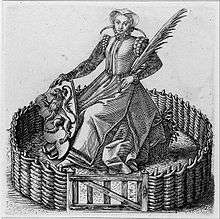
Philip's financial difficulties were straightened out by the end of 1577.[27] This enabled him to send a new Spanish army from Italy, under the command of Alexander Farnese, Duke of Parma. These troops arrived in January 1578, and were soon venturing into the territory of the States-General. Parma routed the States-General's troops in the Battle of Gembloux on 31 January 1578, allowing royalist forces to advance to Leuven. New troops raised by the States General with support of Elizabeth of England defeated the Spanish armies at the Rijmenam.[28] The States-General were not able to exploit their advantage. Parma became the new governor general after the death of Juan de Austria and laid siege to Maastricht in 1579. Parma's troops entered the city on 29 June. Parma and his deputies were unable to prevent a massacre of the garrison or Maastricht's civilians.[29]
Holland had started the construction of a ring defence of trace-italienne type fortresses to stop Spanish armies roaming around in their lands.[30] Among the new fortresses were Geertruidenberg, Zevenbergschen Hoek (both across the Hollands Diep in Brabant, as the north bank of that estuary was sparsely populated), Gorinchem, Loevestein castle and Woudrichem (at important confluences of rivers), Muiden and Naarden (on the eastern approaches of Amsterdam).[31]
The remaining royalist cities in Holland were won over to the rebel cause. Haarlem, Weesp and Muiden swore allegiance to Orange as stadtholder for the States-General on 22 January 1577.[32] Amsterdam went over to the rebels after negotiations, and under pressure from the continuing Sea Beggar blockade.[33] Alliances between Holland, Utrecht and Gelderland were created to increase border defence.[34] This left many cities in Holland over-garrisoned, and these companies of mercenaries were given in the service of the States-General allowing the establishment of garrisons in the Southern provinces (e.g. in Mechelen, Antwerp, Brussels and Maastricht), and fighting Hierges from Utrecht and the Germans of Nicholas von Polweiler from around Roermond[35] The interest of the States of Holland became evermore focussed on the interest of the Northern provinces, and in spite of warnings of Orange about advances of Parma in Brabant, Holland formalised the defensive Union of Utrecht with its eastern and northern neighbours, on 23 January 1579.[36]
Secession and reconquest (1579–1588)
Ironically, the conservative Walloon provinces had signed their own defensive Union of Arras on 6 January 1579. The treaty was initially signed by Hainault, Artois and Lilloise Flanders and reconfirmed the Pacification and the Perpetual Edict, in addition to neutrality with Spain. In return, Spain was to refrain basing its troops in the provinces. Once Parma accepted these conditions the grievances of the conservative Catholics against Spain were satisfied and they could make a separate peace in the form of the Treaty of Arras in May 1579, in which they renewed their allegiance to Philip.[37]
Meanwhile, Orange and the States-General in Antwerp were less than enthusiastic about the Union of Utrecht. They would far prefer a broader based union, still based on the Pacification and the "religious peace", which both the unions of Utrecht and Arras implicitly rejected. However, rapid developments in divergent directions in both north and south made the attempts at maintaining unity moot. In the north the adherents of the Union of Utrecht managed to consolidate their position in the provinces of Friesland and Gelderland by May, though not without a struggle with the conservatives. However, Overijssel remained divided and in Groningen the city and the stadtholder for the States-General, Count Rennenberg, kept their distance. By the time of the Treaty of Arras it was clear that the split had hardened, and Orange therefore finally conceded defeat and signed the Union of Utrecht on 3 May 1579, while encouraging the Flemish and Brabant cities in Protestant hands to also join the Union.[38]

At this time, on the initiative of Emperor Rudolph II a final attempt was made to attain a general peace between Philip and the States-General in the German city of Cologne. As both sides insisted on mutually exclusive demands these peace talks only served to make the irreconcilability of both parties obvious; there appeared to be no more room for the people who favoured the middle ground, like Count Rennenberg. Rennenberg, a Catholic, now made up his mind to go over to Spain. In March 1580 he called for the provinces in his remit to rise against the "tyranny" of Holland and the Protestants. However, this only served to unleash an anti-Catholic backlash in Friesland and Overijssel. The States of Overijssel were finally convinced to adhere to the Union of Utrecht. Nevertheless, Rennenberg's "treason" posed a severe strategic threat for the Union, especially after Parma sent him reinforcements in June. He managed to capture most of Groningen, Drenthe and Overijssel in the next months.[39]
The territory under nominal States-General control was steadily shrinking in other parts also. Parma made steady progress. After taking Maastricht in June 1579, he seized Kortrijk in February 1580, after a four-month siege. The States-General replied by recapturing Mechelen in April after which the victorious English mercenaries sacked the town in what has become known as the English Fury.[40] Orange by now was convinced that the only way to avert total defeat was to regain support of the moderates, alienated by Calvinist radicalism; reassure the still-loyal Catholics in the South; and retain the trust of the German Lutheran princes and the king of France. To attain these objectives he now persuaded the States-General to offer sovereignty over the Netherlands to the younger brother of king Henri of France, François, Duke of Anjou, who in 1578 had already intervened on behalf of the States-General. Anjou was an orthodox Catholic, but also a Politique, who in 1576 had brought about the Edict of Beaulieu, which for a while ensured religious peace in France. As such he was acceptable to moderates in both camps. He also would bring the military and financial support of his brother. Brabant and Flanders (but not Holland and Zeeland) supported this scheme and the States-General concluded the Treaty of Plessis-les-Tours in September 1580 with Anjou. The latter arrived in Antwerp in January 1581, where he took an oath to in effect govern as a "constitutional monarch", and was acclaimed by the States-General as Protector of the Netherlands[41]
_in_1580-81_(Jan_Luyken).jpg)
The secession of the States-General and the area under their nominal control from the Spanish Crown was formalised by the Act of Abjuration of 26 July 1581. The main effect of this Act was to force a number of "fence-sitting" magistrates in the rebellious provinces to finally declare their true allegiance. Many old-guard regents now resigned and were replaced with people whose loyalty to the anti-Spanish cause was not in doubt. The Act also intensified the propaganda war between both sides, as it took the form of a manifest, setting out the principles of the Revolt, just as Orange's Apologie in answer to Philip's ban of June 1580, outlawing him, had done. Both documents are redolent of resistance theories that were also disseminated by the Huguenot Monarchomachs.[42] As such they alienated yet another group of moderates.[43]
Unfortunately, Orange's attempt to paper over the disunity within the States-General by bringing in Anjou did not succeed. Holland and Zeeland acknowledged him perfunctorily, but mainly ignored him, and of the other members of the Union of Utrecht Overijssel, Gelderland and Utrecht never even recognised him. In Flanders his authority never amounted to much either, which meant that only Brabant fully supported him. Under Anjou's nominal direction the split between the north and south was further emphasised. He governed with a Council of State that, though nominally unitary, was in practice divided in two distinct bodies, each responsible for a different theatre of war. Anjou himself concentrated his French troops in the south, leaving Holland and its allies to fend for themselves against Rennenberg (which suited them fine). He proved signally unable to staunch Parma's inexorable advance, however.[44]
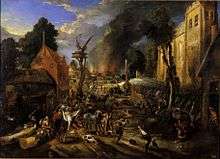
Ironically, Parma had long been hampered by the provision in the Treaty of Arras which prohibited stationing of Spanish mercenaries (the troops of the best quality) in the provinces that belonged to the Southern union. However, after his war with the Turks had finally ended, Philip's finances had significantly improved and he had been able to steadily increase the number of troops available to Parma. By October 1582, Parma had an army of 61,000 troops available, mostly of high quality. By that time the Walloon provinces also relented their opposition against taking in Spanish troops. These improvements were soon translated into military successes. In June 1581 Parma had already captured Orange's own town of Breda, thereby driving a wedge into the territory of the States-General in Brabant. In 1582 he made further advances into Gelderland and Overijssel[44] There the war had been going to and fro between the forces of the Union of Utrecht and the royalists. Rennenberg had died in the Summer of 1581, but was ably replaced by Francisco Verdugo, who after defeating the English mercenaries of Sir John Norris (of Rijmenam fame) opposing him in Friesland at the Battle of Noordhorn. He was in turn defeated by Norreys in trying to capture the important fort at Niezijl. Verdugo then pushed south - capturing Lochem would topple Zutphen and Deventer. However he was forced to lift his siege of Lochem, but on his way back north captured the fortress city of Steenwijk, the key to the north-east of the Netherlands, which always had eluded Rennenberg.[45]
Orange was the victim of an assassination attempt by Juan de Jáuregui on 18 March 1582. He survived, but suffered severe injuries which put him out of the running for an appreciable time. Meanwhile, Anjou had become weary of the restraints placed on his authority by the civilians of the States-General and he attempted to seize power in Flanders and Brabant by way of a military coup. He seized Dunkirk and several other Flemish cities, but in Antwerp the citizens (remembering 1576) came to arms and massacred the French troops in the streets, an event known as the French Fury of 17 January 1583. The popularity of both Anjou and Orange (who was seen as his main promotor) now sank to new lows, especially in Antwerp. Nevertheless, Orange tried to arrange a reconciliation, but both Anjou and the people of Brabant had had enough and Anjou left for France in June 1583.[46]
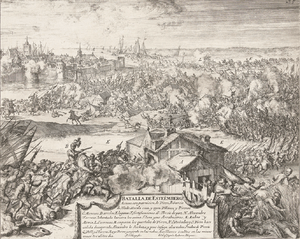
Morale in the cities still held by the States-General in the South sagged. Dunkirk and Nieuwpoort fell without a shot to Parma, leaving only Oostende as a major rebel enclave along the coast. In despair, Orange now left Brabant for good. He again established his headquarters in the Dutch city of Delft in July 1583, followed by the States-General in August (the latter eventually settled in nearby The Hague). He was back where he started from in 1576. His prestige with the States of Holland and Zeeland had appreciably declined since those halcyon days, however. The States had since greatly increased their self-confidence as a budding government.[47]
Meanwhile, Parma's Army of Flanders made inexorable progress. It captured Ypres in April 1584, Bruges in May, and Ghent in September. In this desperate situation Orange started to entertain thoughts of finally accepting the vacant crown of the Count of Holland, which some of his ardent supporters, notably Paulus Buys, had first pressed upon him in 1581. However, since that time enthusiasm had waned, and Amsterdam (led by the regent Cornelis Hooft), Gouda and Middelburg now opposed the plan. In any case, the plan became moot when Orange was assassinated by Balthasar Gérard on 10 July 1584.[48]
The assassination for a while put the States of Holland in disarray, which left the initiative to the much diminished States of Flanders and Brabant in the States-General. The latter were by now getting desperate as they controlled only slivers of their provinces (Parma had by now put Antwerp under siege). They believed that their only succour could come from France. On their behest the States-General therefore started a debate on the merit of once more offering sovereignty to king Henri III of France in September, and over Hooft's and Amsterdam's objections a Dutch embassy was sent to France in February 1585. But the situation in France had deteriorated, the religious strife between Huguenots and Catholics flaring up again, and Henri did not feel strong enough to defy Philip, so he declined the honour.[49]
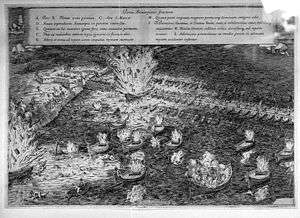
Meanwhile, the "Calvinist republic" of Antwerp was being brought to heel by Parma. He had cut its supply-line from the north by placing a pontoon bridge across the Scheldt river downstream from the city. The usual starvation tactic now began to take hold on the city of 80,000. Morale declined, also because one of the last Brabant holdouts, Brussels, surrendered in March 1585. After a Dutch amphibious assault (during which an attempt was made to blow up the ship-bridge with the use of "Hellburners") failed in April, the city finally surrendered in August. Parma (who was well aware of the counter-productivity of Alba's terror tactics) treated the inhabitants leniently, but many Protestants nevertheless migrated to the northern provinces, swelling the stream of often wealthy merchants and skilled labourers with a Protestant background that sought refuge there in this period. A side effect of this wholesale migration was that the economic strength of the reconquered provinces steadily declined, while that of especially Holland and Zeeland mightily increased.[50]
The States-General in their extremity now turned to the English monarch Elizabeth I with an offer of sovereignty. Elizabeth had been approached as early as 1573 by the States of Holland with a similar offer for the province, but then she haughtily declined, as she generally disapproved of rebellion (and Dutchmen). Now, however, the English government reconsidered in view of the gains Parma was making, which also had the unwanted effect of strengthening Catholic anti-government sentiment in England. Elizabeth (though declining to take up the offer of sovereignty) therefore decided to extend an English protectorate over the Netherlands, be it under strict conditions to protect her interests. She offered to send an expeditionary force of 6,350 foot and 1,000 horse, the cost to be shared by the States-General, provided her nominee, Robert Dudley, 1st Earl of Leicester, would be put in both military and political charge of the country as governor-general. Furthermore, he should govern through a reconstituted Council of State, on which the English government would have two voting members (one of which was the Clerk of the Privy Council, Sir Thomas Wilkes), and she was to be given the fortresses of Flushing and Brill as surety for the loans she extended. The States-General agreed to this in the Treaty of Nonsuch of 20 August 1585. This was the first instance in which the rebel state was diplomatically recognised by a foreign government (the treaty with Anjou having been "private").[51]
Leicester's intervention in the Netherlands proved to be a mixed blessing. He was to be a rallying point for the forces in the Netherlands that were opposed to the hegemony of the States of Holland. As a protector of the Puritans in England, he was seen as a natural ally by the "strict" faction of Calvinists in the Netherlands, who had opposed Orange's policy of "religious peace" and now were arrayed against the "lax" Dutch regents who favoured an Erastian Church order, a bone of contention for many years to come. Those Dutch regents, ably led by the Land's Advocate of Holland, Johan van Oldenbarnevelt, opposed Leicester from the start because they rightly identified him as the focus of the opposition in the Netherlands to the power they had acquired during the course of the Revolt. Beside the hard-line Calvinists, that opposition consisted of the Dutch nobility, whose power had declined in favour of that of the despised merchant class that the regents represented, and the factions in the other provinces, such as Utrecht and Friesland, that heartily resented Holland's supremacy.[52]
The first conflict arose during the negotiations with Leicester in January 1586 over the exact contents of his commission as governor-general. The Treaty of Nonsuch provided that stadtholders for the individual provinces would henceforth be appointed by the Council of State, so as to give England a say in the matter. Nevertheless, in Friesland and Groningen William Louis, Count of Nassau-Dillenburg (the son of Orange's brother Jan), and in Utrecht, Gelderland and Overijssel Adolf van Nieuwenaar had been appointed by the States-General in early 1585, before the treaty. In a show of bad faith the States of Holland and Zeeland had then appointed the second legitimate son of Orange, Maurice of Nassau,[53] stadtholder in their provinces just before Leicester arrived. To add insult to injury, the States insisted that all stadtholders derived their authority from the sovereign States of the provinces that appointed them, so Leicester could claim no say in the matter (an argument that would play an important role in future constitutional conflicts). Confronted with this fait accompli he had no choice but to acquiesce.[54]
Leicester also clashed with Holland over matters of policy like the representation of the States of Brabant and Flanders, who by now no longer controlled any significant areas in their provinces, in the States-General. From 1586 on they were barred from taking part in the deliberations over Leicester's objection, though he managed to retain their seats in the Council of State for them. Once the States-General were thus deprived of the membership of the last Southern provinces, one may in effect start using the name Dutch Republic for the new state. Holland also opposed Leicester's embargo on "trade with the enemy." Superficially, this made sense from a strategic point of view, and the embargo proved quite effective after Leicester put it in force in April 1586, causing much hardship in the Spanish-controlled territories in the next Winter. However, the embargo also hit the Dutch merchants very hard, as much of the grain trade on the Baltic was now diverted to England. The Dutch regents therefore preferred a system of control with licenses that had the added benefit of bringing in much-needed revenue. For the moment Leicester prevailed on this point, however.[55]
The political strains between Leicester and Holland intensified when the Calvinist hard-liners, in Utrecht, led by Gerard Prouninck, seized power in that province in August 1586. This provided Leicester with an anti-Holland power base from which he could make difficulties for the Dutch regents in other provinces, especially Friesland, also. When Leicester temporarily returned to England in December 1586, Holland immediately set to work to recover the lost ground. New regulations were put in force that required every officer in the pay of Holland to accept his commission from the stadtholder, Maurice, who also had to approve all troop movements. Leicester's trade embargo was emasculated. Meanwhile, much mutual irritation had arisen between the Dutch populace and the English troops garrisoned in many towns. In January 1587 the English garrisons at Deventer and Zutphen defected to Spain, followed by those in Zwolle, Arnhem and Ostend. This contributed to anti-English feeling under the populace, which helped undermine the pro-English Utrecht faction, that had been agitating for offering sovereignty to Elizabeth once again. When Leicester returned to the Netherlands he found his friends weakened so much that he concluded that he would have to seize power by force to get the situation under control. After preparations during the Summer, Leicester occupied Gouda, Schoonhoven and a few other cities in September 1587. An attempt to arrest Maurice and Oldenbarnevelt in The Hague failed, however, as did an attempted insurrection of hardline Calvinists in Leiden. When a personal attempt by Leicester to get Amsterdam in his camp also failed, he gave up and returned to England in December 1587. Thus ended the last attempt to keep the Netherlands a "mixed monarchy", under foreign government. The northern provinces now entered a period of more than two centuries of republican government.[56]
The Dutch Republic resurges (1588–1609)
Politics of the Dutch Republic
The Dutch Republic was not proclaimed with great fanfare. In fact, after the departure of Leicester the States of the several provinces and the States-General conducted business as usual. To understand why, one has to look at the polemic that took place during 1587 about the question who held sovereignty. The polemic was started by the English member of the Council of State, Sir Thomas Wilkes, who published a learned Remonstrance in March 1587, in which he attacked the States of Holland because they undermined the authority of Leicester to whom, in Wilkes view, the People of the Netherlands had transferred sovereignty in the absence of the "legitimate prince" (presumably Philip). The States of Holland reacted with an equally learned treatise, drawn up by the pensionary of the city of Gouda, François Vranck[57] on their behalf, in which it was explained that popular sovereignty in Holland (and by extension in other provinces) in the view of the States resided in the vroedschappen and nobility, and that it was administered by (not transferred to) the States, and that this had been the case from time immemorial. In other words, in this view the republic already existed so it did not need to be brought into being.[58] Vranck's conclusions reflected the view of the States at that time and would form the basis of the ideology of the States-Party faction in Dutch politics, in their defence against the "monarchical" views of their hard-line Calvinist and Orangist enemies in future decades.[59]
The latter (and many contemporary foreign observers and later historians) often argued that the confederal government machinery of the Netherlands, in which the delegates to the States and States-General constantly had to refer back to their principals in the cities, "could not work" without the unifying influence of an "eminent head" (like a Regent or Governor-General, or later a stadtholder). However, the first years of the Dutch Republic proved different (as in hindsight the experience with the States-General since 1576, ably managed by Orange, had proved). Oldenbarnevelt proved to be Orange's equal in virtuosity of parliamentary management. The government he informally led proved to be quite effective, at least as long as the war lasted.[60] In the three years after 1588 the position of the Republic improved appreciably, despite setbacks like the betrayal of Geertruidenberg to Parma by its English garrison in 1588.[61] The change was due to both external and internal factors that were interrelated.
Economics and demographic changes in the Netherlands
Internally, probably thanks to the influx of Protestant refugees from the South, which temporarily became a flood after the fall of Antwerp in 1585, the long-term economic boom was ignited that in its first phase would last until the second decade of the next century. The southern migrants brought the entrepreneurial qualities, capital, labour skills and know-how that were needed to start an industrial and trade revolution. The economic resources that this boom generated were easily mobilised by the budding "fiscal-military state" in the Netherlands, that had its origin, ironically, in the Habsburg attempts at centralisation earlier in the century. Though the Revolt was in the main motivated by resistance against this Spanish "fiscal-military state" on the absolutist model, in the course of this resistance the Dutch constructed their own model that, though explicitly structured in a decentralised fashion (with decision-making at the lowest, instead of the highest level) was at least as efficient at resource mobilisation for war as the Spanish one. This started in the desperate days of the early Revolt in which the Dutch regents had to resort to harsh taxation and forced loans to finance their war efforts. However, in the long run these very policies helped reinforce the fiscal and economic system, as the taxation system that was developed formed an efficient and sturdy base for the debt-service of the state, thereby reinforcing the trust of lenders in the credit-worthiness of that state. Innovations, such as the making of a secondary market for forced loans by town governments helped merchants to regain liquidity, and helped start the financial system that made the Netherlands the first modern economy. Though in the early 1590s this fiscal-military state was only in its early stages and not as formidable as it would become in the next century, it still already made the struggle between Spain and the Dutch Republic less unequal than it had been in the early years of the Revolt.[62]
The Spanish Armada
Externally, the preparations Philip was making for an invasion of England were all too evident. This growing threat prompted Elizabeth to take a more neutral stance in the Netherlands. Oldenbarnevelt proceeded unhindered to break the opposition.[63] She appreciated that she needed Dutch naval co-operation to defeat the threatened invasion and that opposing Oldenbarnevelt's policies, or supporting his enemies, was unlikely to get it. The position of Holland was also improved when Adolf of Nieuwenaar died in a gunpowder explosion in October 1589, enabling Oldenbarnevelt to engineer his succession as stadtholder of Utrecht, Gelderland and Overijssel by Maurice, with whom he worked hand in glove.[64]
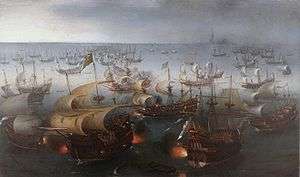
Oldenbarnevelt managed to wrest power away from the Council of State, with its English members (though the Council would have an English representation until the English loans were repaid by the end of the reign of James I). Instead, military decisions were more and more made by the States-General (with its preponderant influence of the Holland delegation), thereby usurping important executive functions from the Council.[65]
The role of the budding Dutch navy in the defeat of the Spanish Armada in August 1588, has often been under-exposed. It was crucial, however. After the fall of Antwerp the Sea-Beggar veterans under admiral Justinus van Nassau (the illegitimate elder brother of Maurice) had been blockading Antwerp and the Flemish coast with their nimble flyboats. These mainly operated in the shallow waters off Zeeland and Flanders that larger warships with a deeper draught, like the Spanish and English galleons, could not safely enter. The Dutch therefore enjoyed unchallenged naval superiority in these waters, even though their navy was inferior in naval armament. An essential element of the plan of invasion, as it was eventually implemented, was the transportation of a large part of Parma's Army of Flanders as the main invasion force in unarmed barges across the English Channel. These barges would be protected by the large ships of the Armada. However, to get to the Armada, they would have to cross the zone dominated by the Dutch navy, where the Armada could not go. This problem seems to have been overlooked by the Spanish planners, but it was insurmountable. Because of this obstacle, England never was in any real danger. However, as it turned out, the English navy defeated the Armada before the embarkation of Parma's army could be implemented, turning the role of the Dutch moot. The Army of Flanders escaped the drowning death Justinus and his men had in mind for them, ready to fight another day[66]
Dutch Army reforms
.jpg)
Henry IV of France's succession to the French throne in 1589 occasioned a new civil war in France, in which Philip soon intervened on the Catholic side. He ordered Parma to use the Army of Flanders for this intervention and this put Parma in the unenviable position of having to fight a two-front war. There was at first little to fear from the Dutch, and he had taken the added precaution of heavily fortifying a number of the cities in Brabant and the north-eastern Netherlands he had recently acquired, so he could withdraw his main army to the French border with some confidence. However, this offered the Dutch a respite from his relentless pressure that they soon put to good use. Under the two stadtholders, Maurice and William Louis, the Dutch army was in a short time thoroughly reformed from an ill-disciplined, ill-paid rabble of mercenary companies from all over Protestant Europe, to a well-disciplined, well-paid professional army, with many soldiers, skilled in the use of modern fire-arms, like arquebuses, and soon the more modern muskets. The use of these fire-arms required tactical innovations like the counter-march of files of musketeers to enable rapid volley fire by ranks; such complicated manoevres had to be instilled by constant drilling. These reforms were later emulated by other European armies in the 17th century.[67]
Besides these organisational and tactical reforms, the two stadtholders also developed a new approach to siege warfare. They appreciated the peculiar difficulties of the terrain for this type of warfare in most of the Netherlands, which necessitated much labour for the digging of investments. Previously, many soldiers disdained the manual work required and armies usually press-ganged hapless peasants. Maurice, however, required his soldiers to do the digging, which caused an appreciable improvement in the quality of the work. Maurice also assembled an impressive train of siege artillery, much larger than armies of the time usually had available, which enabled him to systematically pulverise enemy fortresses. He was to put this to good use, when the Republic went on the offensive in 1591.
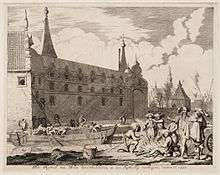
Already in 1590 Breda was recaptured with a ruse from which having been aided considerably by an English army under Sir Francis Vere[68] and Maurice used his much enlarged army[69] with newly developed transportation methods using rivercraft, to sweep the IJssel-river valley, capturing Zutphen and Deventer; then invade the Ommelanden in Groningen, capturing all Spanish forts and defeated Parma during the Siege of Knodsenburg. He ended the campaign with the conquest of Hulst in Flanders and Nijmegen in Gelderland. In one fell swoop this transformed the eastern part of the Netherlands, which had hitherto been in Parma's hands. The next year Maurice joined his cousin William Louis in the siege of Steenwijk, pounding that strongly defended fortress with 50 artillery pieces, that fired 29,000 shot. The city surrendered after 44 days. During the same campaign year the formidable fortress of Coevorden was also reduced; it surrendered after a relentless bombardment of six weeks. Drenthe was now brought under control of the States-General.[70]
Despite the fact that Spanish control of the northeastern Netherland now hung by a thread, Holland insisted that first Geertruidenberg would be captured, which happened after an epic textbook siege, which even the great ladies of The Hague treated as a tourist attraction, in June 1593. Only the next year the stadtholders concentrated their attention on the northeast again, where meanwhile the particularist forces in Friesland, led by Carel Roorda, were trying to extend their hegemony over the other north-eastern provinces. This was temporarily resolved by a solution imposed by Holland, putting Friesland in its place, which the Frisians understandably resented. Holland also attempted to avoid the expense of a lengthy siege of the strongly defended and strongly pro-Spanish city of Groningen by offering that city an attractive deal that would maintain its status in its eternal conflict with the Ommelanden. This diplomatic initiative failed however, and Groningen was subjected to a two-month siege. After its capitulation the city was treated "leniently", though Catholic worship was henceforth prohibited and the large body of Catholic clergy that had sought refuge in the city since 1591 forced to flee to the Southern Netherlands. The province of Groningen, City and Ommelanden, was now admitted to the Union of Utrecht, as the seventh voting province under a compromise imposed by Holland, that provided for an equal vote for both the city and the Ommelanden in the new States of Groningen. In view of the animosity between the two parties, this spelled eternal deadlock, so a casting vote was given to the new stadtholder, William Louis, who was appointed by the States-General, in this instance.[71] The fall of Groningen also rendered Drenthe secure and this area was constituted as a separate province (as annexation by either Friesland or Groningen was unacceptable to the other party) with its own States and stadtholder (again William Louis), though Holland blocked its getting a vote in the States-General.[72]
Dutch offensive of 1597
The fall of Groningen also changed the balance of forces in the German county of East Friesland, where the Lutheran Count of East Frisia, Edzard II, was opposed by the Calvinist forces in Emden. The States-General now laid a garrison in Emden, forcing the Count to recognise them diplomatically in the Treaty of Delfzijl of 1595. This also gave the Republic a strategic interest in the Ems River valley, which was reinforced during the stadtholders' large offensive of 1597. Maurice first seized the fortress of Rheinberg, a strategic Rhine crossing, and subsequently Groenlo, Oldenzaal, and Enschede, before crossing into Germany and capturing Lingen and the county of the same name. This reinforced Dutch hegemony in the Ems valley. Capture of these cities secured for a while the dominance of the Dutch over eastern Overijssel and Gelderland, which had hitherto been firmly in Spanish hands.[73]
Rise of Philip III and attacks on Dutch shipping
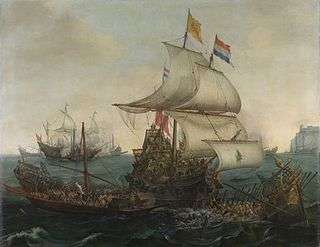
Meanwhile, however, the civil war in France was drawing to a close. The Dutch viewed this with some trepidation, because though Henry IV was the winner, the end of hostilities after the Peace of Vervins of May 1598 would free the Army of Flanders again for operations in the Netherlands. Soon after, Philip died, and his Will provided a new surprise. It turned out that he had willed the Netherlands to his daughter Isabella and her husband Archduke Albert, who would henceforth reign as co-sovereigns. This sovereignty was largely nominal as the Army of Flanders was to remain in the Netherlands, largely paid for by the new king of Spain, Philip III. Nevertheless, ceding the Netherlands made it theoretically easier to pursue a compromise peace, as both the Archdukes, and the chief minister of the new king, the duke of Lerma were less inflexible toward the Republic than Philip II had been. Soon secret negotiations were started which, however, proved abortive because Spain insisted on two points that were nonnegotiable to the Dutch: recognition of the sovereignty of the Archdukes (though they were ready to accept Maurice as their stadtholder in the Dutch provinces) and freedom of worship for Catholics in the north. The Republic was too insecure internally (the loyalty of the recently conquered areas being in doubt) to accede on the latter point, while the first point would have invalidated the entire Revolt. The war therefore continued.[74]
However, peace with France and the secret peace negotiations had temporarily slackened Spain's resolve to pay its troops adequately and this had occasioned the usual widespread mutinies. The Army of Flanders now temporarily in disarray, Oldenbarnevelt and the civilians in the States-General spied a strategic opportunity to deal the Archdukes a heavy blow. They forced a deep strike into Flanders on a reluctant Maurice in the direction of the port of Dunkirk that had grown into a hotbed of privateers that did much damage to Dutch shipping. Maurice now flung his model army into Flanders after a large amphibious operation from Flushing and started his advance along the coast. This incursion brought an immediate end to the "industrial action" of the Spanish troops, enabling Albert to launch a strike into Maurice's flank. Somewhat hindered by all seven members of the States-General, who tried to micro-manage the campaign as deputies-in-the-field, Maurice was now cornered by Albert near the port of Nieuwpoort and forced to give battle on 2 July 1600. This was a test by fire of the Dutch army and the new tactics developed by the stadtholders against the still-formidable Spanish infantry and Maurice was none too sure about its outcome. However, the new tactics of volley-fire and artillery-supported infantry fighting got the better of the Spanish pikemen and Maurice personally routed the Spaniards in a cavalry charge.[75] It was a close-run thing, however, and strategically worthless, as Maurice retreated post-haste to the safety of Zeeland. To add insult to injury, a privateer fleet managed to break the blockade of Dunkirk and wreaked havoc on the Dutch herring fleet soon, destroying 10% of the fleet of Dutch herring busses in August.[76]
Raid on Southern Chile
The Dutch–Spanish war also reached South America. In 1600, local Huilliche (a Mapuche subgroup) joined the Dutch corsair Baltazar de Cordes to attack the Spanish settlement of Castro in Chile.[77][78] While this was an isolated attack, the Spanish believed the Dutch could attempt to ally with the Mapuches and establish a stronghold in southern Chile.[79] The Spanish knew of the Dutch plans to establish themselves at the ruins of Valdivia so they attempted to re-establish Spanish rule there before the Dutch arrived again.[80] The Spanish attempts were thwarted in the 1630s when Mapuches did not allow the Spanish to pass through their territory.[80]
Stalemate, fortress building and truce
%2C_prins_van_Oranje%2C_in_de_slag_bij_Nieuwpoort_(1600).jpg)
The next four years showed an apparent stalemate. The Archdukes decided that before taking on the Republic it was important to subdue the last Protestant enclave on the Flemish coast, the port of Ostend. The siege took three years and eighty days. Meanwhile, the stadtholders mopped up some more Spanish fortresses, like Grave in Brabant and Sluys and Aardenburg in what was to become States Flanders. Though these victories deprived the Archdukes of much of the propaganda value of their own victory at Ostend, the loss of the city was a severe blow to the Republic, and it brought about another Protestant exodus to the North.[81]
The supreme command of the Army of Flanders had now been transferred to Ambrosio Spinola who proved to be a worthy opponent of Maurice. In a brilliant campaign in 1605 he first outwitted Maurice by feigning an attack on Sluys, leaving Maurice far in his rear while he actually attacked the eastern Netherlands by way of Münster, Germany. He soon appeared before Oldenzaal (only recently captured by Maurice) and the predominantly Catholic city opened its gates without firing a shot. Next he captured Lingen. With both towns in Spanish hands the Dutch had to evacuate Twenthe and retire to the IJssel river.

Spinola returned the next year and caused a panic in the Republic when he invaded the Zutphen quarter of Gelderland, showing that the interior of the Republic was still vulnerable to Spanish attack. However, Spinola was satisfied with the psychological effect of his incursion and did not press the attack. Maurice decided on a rare autumn campaign in an attempt to close the apparent gap in the Republic's eastern defences. He retook Lochem, but his siege of Oldenzaal failed in November 1606. This was the last major campaign on both sides before the Truce that was concluded in 1609. The strategic result of the Spanish gains of 1605–06 was that the Twenthe and Zutphen quarters were to remain a kind of No man's land right down to 1633, during which they were forced to pay tribute to the Spanish forces that often roamed there at will.[82]
Both sides now embarked on an intensification of the fortress-building spree that had begun in the mid-1590s, enveloping the Republic in a double belt of fortresses on its outer borders (an outer Spanish and an inner Dutch belt). This belt ran from Emden in the northeast via Bourtange, Coevorden, Zwolle, the line of the IJssel, with Deventer and Zutphen; to Arnhem and Nijmegen, and then west, along the Meuse to Grave, Heusden and Geertruidenberg; and finally south along the line through Bergen op Zoom to Lillo, north of Antwerp, and west again to the coast at Cadzand via Sluys.[83] The Dutch fortresses, mostly outside the provinces of the Union of Utrecht proper, were garrisoned with mercenary troops that, though paid for the account of individual provinces, were under federal command since 1594. The Dutch Staatse leger (States Army) had therefore become a truly federal army, consisting mostly of Scottish, English, German and Swiss mercenaries, but commanded by a Dutch officer corps. This standing army almost trebled in size to 50,000 between 1588 and 1607.[84]
References
- ↑ Tracy, pp. 71–72
- ↑ Tracy, p. 72
- ↑ Tracy, pp. 77–78
- ↑ Tracy, pp. 78–79
- ↑ Parker, pp. 118–120; Parker discusses the financial difficulties the Spanish Crown almost continually encountered, when it often had to fight several wars at the same time as the war in the Netherlands, which forced it to declare bankruptcy several times; see Parker, ch. 6, Financial Resources
- ↑ Israel (1995), pp. 167–168
- ↑ Tracy, p. 80
- ↑ Tracy, pp. 80–81
- ↑ Tracy, p. 82
- ↑ Israel (1995), p. 175
- ↑ Israel (1995), pp. 174–175
- ↑ Tracy, p. 83
- ↑ Israel (1995), p. 177
- ↑ Israel (1995), g. 178; Tracy, p. 86
- ↑ Israel (1995), p. 178
- 1 2 Tracy, p. 92
- ↑ Tracy, pp. 92–93
- ↑ Israel (1995), p. 180
- ↑ Israel (1995), p. 181
- ↑ Tracy, p. 95
- ↑ Tracy, p. 97
- 1 2 Tracy, p. 99
- ↑ Koenigsberger, p. 262; Parker, p.127; Parker mentions that Spain had to default on its loans in 1560 (after a war with France), 1575, 1596, 1607, 1627, 1647 and 1653, every time putting the war effort in jeopardy; the 1575 default led directly to the 1576 mutiny of foreign troops in the Army of Flanders.
- ↑ Koenigsberger, pp. 260–272; Tracy, pp. 135–136
- ↑ Tracy, pp. 137–138
- ↑ In old Dutch the word for "garden" often means "fence."
- ↑ The system of "contributions" Requesens adopted in 1574 outside the areas where regular taxes could be collected, helped to augment revenue from the Netherlands (though it did not help avert the mutiny of 1576). Parma later "improved" on this system of forced contributions by regularizing the arbitrary exactions of the Spanish troops in the form of brandschattingen, to a system of formalized extortions, in which communities paid "protection money" to the Spanish "superintendent of contributions" to avoid being sacked, Parker, pp. 120–122
- ↑ Tracy, p. 141
- ↑ Tracy, p. 142
- ↑ Tracy, pp. 149–150
- ↑ Tracy, p. 150
- ↑ Tracy, p. 152
- ↑ Tracy, pp. 153–4
- ↑ Tracy, p. 156
- ↑ Tracy, p. 159; Israel (1995), pp. 191–192
- ↑ The treaty is often called the "constitution" of the Dutch Republic. This is only partially true, however. This "constitution" in the main consisted of the constitutional framework that had organically grown in the Burgundian and Habsburg Netherlands in the previous decades, which structure was simply retained by the Republic. However, the articles of the treaty provided additional building blocks for the constitution by providing an explicit framework for the budding Confederation. It was signed in the city of Utrecht by the representatives of Holland, Zeeland, Utrecht, the Ommelanden around Groningen city, and the stadtholder of Gelderland, Orange's brother Jan, who presumed to sign for the divided States of Gelderland. Ironically, Jan van Nassau was reluctantly accepted by the anti-Orange and anti-Holland bloc in the Gelderland States, because they mistook him for a Lutheran moderate, and as such a bulwark against Calvinist encroachments; Israel (1995), p. 191
- ↑ Koenigsberger, pp. 290–291
- ↑ Israel (1995), pp. 201–2
- ↑ Israel (1995), pp. 205–208
- ↑ Israel (1995), p. 208
- ↑ The role of the Archduke Matthias as nominal governor-general had now become superfluous, and he was bought off with a generous annuity in March [1581]; Israel (1995), pp. 208–9
- ↑ Though Van Gelderen maintains that the Dutch versions actually antedate the monarchomach publications; Van Gelderen, pp. 269–276
- ↑ Israel (1995), pp. 209–11
- 1 2 Israel (1995), p. 212
- ↑ Tracy, pp. 168–169
- ↑ Israel (1995), p. 213
- ↑ Israel (1995), pp. 213–4
- ↑ Israel (1995), pp. 214–6
- ↑ Israel (1995), pp. 218–9
- ↑ Israel (1995), p. 219
- ↑ Israel (1995), pp. 219–20
- ↑ Israel (1995), pp. 221–2
- ↑ Orange's eldest son, Philip William, now the Prince of Orange, was in Spanish hands; the second son Justinus van Nassau, was illegitimate.
- ↑ Israel (1995), p. 224
- ↑ Israel (1995), pp. 225–6
- ↑ Israel (1995), pp. 228–30
- ↑ Entitled in translation:Short exposition of the right exercised from old times by the knighthood, nobles and towns of Holland and Westvriesland for the maintenance of the liberties, rights, privileges and laudable customs of the country; Van Gelderen, p. 204
- ↑ Van Gelderen, p. 209; Koenigsberger, pp. 308–10
- ↑ Van Gelderen, pp. 206–7
- ↑ Koenigsberger, p. 313
- ↑ Israel (1995), p. 234
- ↑ Glete, pp. 145–55
- ↑ Israel (1995), pp. 235–7
- ↑ Israel (1995), p. 237
- ↑ Israel (1995), pp. 238–40
- ↑ Israel, J.I. and Parker, G. (1991) "Of Providence and Protestant Winds: the Spanish Armada of 1588 and the Dutch armada of 1688", in: The Anglo-Dutch moment. Essays on the Glorious Revolution and its world impact. Cambridge U.P., ISBN 0-521-39075-3; pp. 349–51
- ↑ Israel (1995), pp. 267–71; Glete, pp. 155–62
- ↑ Knight, Charles Raleigh: Historical records of The Buffs, East Kent Regiment (3rd Foot) formerly designated the Holland Regiment and Prince George of Denmark's Regiment. Vol I. London, Gale & Polden, 1905, pp 36-40
- ↑ It grew from 20,000 in 1588 to 32,000 by 1595; Israel (1995), p. 242
- ↑ Israel (1995), pp. 241–5
- ↑ In later years, Groningen, like the other provinces would itself appoint its stadtholder.
- ↑ Israel (1995), pp. 246–50
- ↑ Israel (1995), p. 253
- ↑ Israel (1995), pp. 253–257
- ↑ Thanks mainly to its easily memorable date, this battle is one of the few most Dutchmen are able to recite. Together with Turnhout this was one of the few pitched battles the States Army was able to win. However, remember who won the war: Jemmingen, Jodoigne and Gembloux never seemed to afford Spain a decisive advantage.
- ↑ Israel (1995), pp. 258–9
- ↑ "La encomienda". Memoria chilena (in Spanish). Biblioteca Nacional de Chile. Retrieved January 30, 2014.
- ↑ Urbina Burgos, Rodolfo (1990). "La rebelión indigena de 1712: Los tributarios de Chiloé contra la encomienda" (PDF). Tiempo y espacio (in Spanish). 1: 73–86. Retrieved February 22, 2014.
- ↑ Clark 2006, p. 13.
- 1 2 Bengoa 2003, pp. 450–451.
- ↑ Israel (1995), p. 260
- ↑ Israel (1995), pp. 261–2
- ↑ Israel (1995), p. 263, map
- ↑ Israel (1995), pp. 263–7; Glete, p. 155
Sources
- Bengoa, José (2003). Historia de los antiguos mapuches del sur (in Spanish). Santiago: Catalonia. ISBN 956-8303-02-2.
- Gelderen, M. van (2002), The Political Thought of the Dutch Revolt 1555–1590, Cambridge University Press, ISBN 0-521-89163-9
- Glete, J. (2002),War and the State in Early Modern Europe. Spain, the Dutch Republic and Sweden as Fiscal-Military States, 1500–1660, Routledge, ISBN 0-415-22645-7
- Israel, Jonathan (1989), Dutch Primacy in World Trade, 1585–1740, Clarendon Press, ISBN 0-19-821139-2
- Israel, Jonathan (1990), Empires and Entrepôts: The Dutch, the Spanish Monarchy, and the Jews, 1585–1713, Continuum International Publishing Group, ISBN 1-85285-022-1
- Israel, Jonathan (1995), The Dutch Republic: Its Rise, Greatness, and Fall 1477–1806, Clarendon Press, Oxford, ISBN 0-19-873072-1
- Koenigsberger, H.G. (2007) [2001], Monarchies, States Generals and Parliaments: The Netherlands in the Fifteenth and Sixteenth Centuries, Cambridge University Press, ISBN 978-0-521-04437-0
- Parker, G. (2004) The Army of Flanders and the Spanish Road 1567–1659. Second edition. Cambridge University Press, ISBN 978-0-521-54392-7 paperback
- Tracy, J.D. (2008), The Founding of the Dutch Republic: War, Finance, and Politics in Holland 1572–1588, Oxford University Press, ISBN 978-0-19-920911-8
